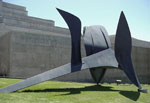 Berkeley
-- "The Hawk for Peace," Alexander Calder's majestic stabile
of painted steel displayed outside the University of California,
Berkeley Art Museum and Pacific Film Archive, is getting
a major makeover.
Berkeley
-- "The Hawk for Peace," Alexander Calder's majestic stabile
of painted steel displayed outside the University of California,
Berkeley Art Museum and Pacific Film Archive, is getting
a major makeover.
During
the conservation treatment that starts on campus this week,
the 11 1/2-foot-wide and 23-foot-long sculpture that stretches
13 feet high will be shrouded in scaffolding and a protective,
shrink-wrap vertical covering. Materials will blanket the
lawn to protect it as well.
The eight-
to 10-day project managed by UC Berkeley Capital Projects
entails applying a chemical stripping agent by hand trowel
to gently remove rust and scale, along with an undercoat
used when the artwork was created in 1968. The cutting-edge
product, neither caustic nor acidic, essentially deoxidizes
the paint and is an alternative to harsh treatments such
as sandblasting.
Once
the bare metal has been exposed, a new primer and coat of
matte black paint will be applied to protect the surface
and restore the work to its original glory. Heading that
part of the project will be Jeffco Painting of Mare Island,
a firm that specializes in industrial painting and that
currently is working on the Bay and Benicia bridges.
UC Berkeley
will take extra precautions during the makeover, primarily
to assure containment and proper disposal of the lead in
the old paint. The campus will use certified personnel with
training in the handling and disposal of toxic materials,
erect a fence around the sculpture to prevent unauthorized
access, and monitor the air at several sites around the
sculpture during the paint removal.
Born
in 1898, Calder became best known for inventing both the
mobile and the stabile, a non-moving sculpture, as well
as for creating wire sculptures. As he got older, his sculptures
increased in size. Calder died in 1976.
"The
Hawk for Peace" was commissioned by the UC Berkeley Art
Museum and donated by the artist in memory of his brother-in-law,
Kenneth Aurand Hayes, a member of UC Berkeley's Class of
1916.
It first
was installed on the lawn facing South Hall, near the Campanile,
in 1969 and then moved to the Bancroft Avenue entrance to
the museum when it opened in 1970. Originally titled "Boeing,"
the piece was renamed ""The Hawk," and, finally, "The Hawk
for Peace."
Funds
for the project were raised through an appeal to UC Berkeley
Art Museum members.
At the
same time, museum authorities sought out the right replacement
paint.
"Painters
and anybody who knows paint has great admiration for that
(Calder's paint), because it was so tenacious and durable,"
said Barney Bailey, the museum's exhibitions designer, noting
how well the paint sealed and protected the steel from corrosion
and rust. "The paint of that period is not rivaled by anything
that is produced today."
The plus
side of today's paints is that they have no lead, and the
paint Calder used for "The Hawk for Peace" contained 2 percent
lead, according to Gary Bayne, a UC Berkeley environmental
health and safety specialist.
Though
2 percent isn't much, since 1978, the Centers for Disease
Control and Prevention have prohibited the manufacture of
paint with more than 0.006 percent lead. Most bridges and
ships, painted before current requirements became law, feature
paint with as much as 60 percent lead.
"It was
important that the paint compare aesthetically to retain
the artist's intent," said Bailey.